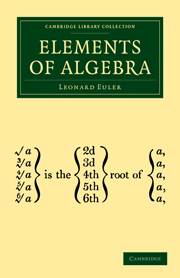Book contents
- Frontmatter
- ADVERTISEMENT
- MEMOIR OF THE LIFE AND CHARACTER OF EULER, BY THE LATE FRANCIS HORNER, ESQ., M. P.
- ADVERTISEMENT BY THE EDITORS OF THE ORIGINAL, IN GERMAN
- ADVERTISEMENT BY M. BERNOULLI, THE FRENCH TRANSLATOR
- Contents
- PART I Containing the Analysis of Determinate Quantities
- SECTION I Of the Different Methods of calculating Simple Quantities
- SECTION II Of the different Methods of calculating Compound Quantities
- SECTION III Of Ratios and Proportions
- Chap. I Of Arithmetical Ratio, or the Difference between two Numbers
- Chap. II Of Arithmetical Proportion
- Chap. III Of Arithmetical Progressions
- Chap. IV Of the Summation of Arithmetical Progressions
- Chap. V Of Figurate, or Polygonal Numbers
- Chap. VI Of Geometrial Ratio
- Chap. VII Of the greatest Common Divisor of two given Numbers
- Chap. VIII Of Geometrical Proportions
- Chap. IX Observations on the Rules of Proportion and their Utility
- Chap. X Of Compound Relations
- Chap. XI Of Geometrical Progressions
- Chap. XII Of Infinite Decimal Fractions
- Chap. XIII Of the Calculation of Interest
- SECTION IV Of Algebraic Equations, and of the Resolution of those Equations
- PART II Containing the Analysis of Indeterminate Quantities
- ADDITIONS BY M. DE LA GRANGE
Chap. II - Of Arithmetical Proportion
Published online by Cambridge University Press: 05 July 2011
- Frontmatter
- ADVERTISEMENT
- MEMOIR OF THE LIFE AND CHARACTER OF EULER, BY THE LATE FRANCIS HORNER, ESQ., M. P.
- ADVERTISEMENT BY THE EDITORS OF THE ORIGINAL, IN GERMAN
- ADVERTISEMENT BY M. BERNOULLI, THE FRENCH TRANSLATOR
- Contents
- PART I Containing the Analysis of Determinate Quantities
- SECTION I Of the Different Methods of calculating Simple Quantities
- SECTION II Of the different Methods of calculating Compound Quantities
- SECTION III Of Ratios and Proportions
- Chap. I Of Arithmetical Ratio, or the Difference between two Numbers
- Chap. II Of Arithmetical Proportion
- Chap. III Of Arithmetical Progressions
- Chap. IV Of the Summation of Arithmetical Progressions
- Chap. V Of Figurate, or Polygonal Numbers
- Chap. VI Of Geometrial Ratio
- Chap. VII Of the greatest Common Divisor of two given Numbers
- Chap. VIII Of Geometrical Proportions
- Chap. IX Observations on the Rules of Proportion and their Utility
- Chap. X Of Compound Relations
- Chap. XI Of Geometrical Progressions
- Chap. XII Of Infinite Decimal Fractions
- Chap. XIII Of the Calculation of Interest
- SECTION IV Of Algebraic Equations, and of the Resolution of those Equations
- PART II Containing the Analysis of Indeterminate Quantities
- ADDITIONS BY M. DE LA GRANGE
Summary
890. When two arithmetical ratios, or relations, are equal, this equality is called an arithmetical proportion.
Thus, when a − b = d and p − q = d, so that the difference is the same between the numbers p and q as between the numbers a and b, we say that these four numbers form an arithmetical proportion; which we write thus, a − b = p − q, expressing clearly by this, that the difference between a and b is equal to the difference between p and q.
391. An arithmetical proportion consists therefore of four terms, which must be such, that if we subtract the second from the first, the remainder is the same as when we subtract the fourth from the third; thus, the four numbers 12, 7, 9, 4, form an arithmetical proportion, because 12 − 7 = 9 − 4.
392. When we have an arithmetical proportion, as a − b = p − q, we may make the second and third terms change places, writing a − p = b − q: and this equality will be no less true; for, since a − b = p − q, add b to both sides, and we have a = b + p − q: then subtract p from both sides, and we have a − p = b − q.
- Type
- Chapter
- Information
- Elements of Algebra , pp. 129 - 131Publisher: Cambridge University PressPrint publication year: 2009First published in: 1822

